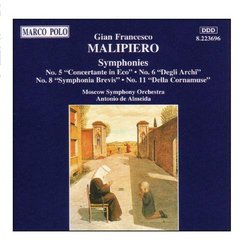A compositional voice that deserves not to be forgotten
Discophage | France | 01/08/2008
(5 out of 5 stars)
"I recently reviewed a Malipiero-Louisville collection and while I thought the music pleasurable, I found nothing in it that was really remarkable and susceptible of sticking in memory (see my review of Gian Francesco Malipiero: Piano Concerto No. 3; Nocturne of songs and Dances; Fantasies of Every Day). I had better memories of this one, and I decided to pull it out of my shelves and give it a new try. Well - my memory was right: this is highly enjoyable music, and oftentimes even quite remarkable.
The outstanding liner notes by John Waterhouse say about everything that needs to be said about the 6th Symphony from 1947, which opens the CD: that, being written for strings alone, it can be best compared with Malipiero's "eight fine, ebulliently inventive quartets" (which I have by G.F. Malipiero: The 8 String Quartets - cheaper found now as Complete String Quartet - and I concur with the description) rather than with his other symphonies; that the composer makes a widespread use, especially in the outer movements, of concertante interactions between "continuo" and "ripieno", e.g. various groupings of solo strings and the full string orchestra, as in a baroque concerto grosso, fittingly reminding us that the composer was also a musicologist, president of the Istituto Italiano Antonio Vivaldi and the editor of several volumes of the Red Priest's instrumental music. What the notes don't quite say is that the music's is intensely lyrical, even in its more boisterous moments (3rd movement), without ever lapsing into trite Romantic sentimentality. The language is not particularly or aggressively modern, still it is decidedly 20th-Century, in a way similar to, say, Honegger's, and also very personal (and in this respect Britten can also come to mind). It is an endearing and highly enjoyable composition, deserving to be counted among the fine 20th century works for string orchestra.
The 5th Symphony, from the same year, is equally remarkable, but this time for its aggressive modernism, at least in its first movement. Its orchestration features prominently two pianos, turning it almost into a Concerto for two pianos. Its language is motoric, dissonant, with crashing piano chords, screaming flutes. The liner notes call it without precedent, in Malipiero's oeuvre as in anyone else's. I'm not so sure, although no name immediately springs to mind that would be typical of that kind of muscular angularity which foreshadows Piano Concertos written some years later by some American composers, like Leon Kirchner (Leon Kirchner Historic Recordings) or Peter Mennin (Mennin: Symphony No.3/Piano Concerto/Symphony No.7). Even composers who have written in a percussive style in the 1920s to 40s (Bartok, Prokofiev) were more gentle and melodic. Antheil maybe, or Mossolov? The third movement is in the same mood, opening with a short percussion section which strikingly brings Varèse's Ionisation to mind; the music then sounds perkily military, fifes and drums and all. The two other movements are more gentle, the fourth being the most clichéd in its very American-sounding pastoral and wistful mood, the second opening with a lamenting bassoon and plaintive viola over swaying piano chords, and rising to a climax of great lyrical intensity - the notes leave it to the listener to decide whether it belongs together stylistically with the first movement, but to me Malipiero's freedom of styles and moods is one of the compositions assets rather than liabilities. Around the 3:30 mark the movement does develop into more angular and dissonant passages, alternately brooding, vehement and dreamy. All in all, it is quite an original composition.
The 8th Symphony from 1964 - the composer was 82 then - is also very interesting, both for its stylistic language - terse, gloomy, rather dissonant, almost expressionist in a way reminiscent of Schoenberg's early atonal music - and its construction processes, with a 3rd and final movement that is almost twice as long as the two previous ones added, and whose sprawling and rambling aspect I take as a quality, a testimony of the composer's freedom of constructional methods, rather than a drawback.
The 11th, written in 1969, is Malipiero's last Symphony (it is actually his 17th, as there are 6 such works that the composer left unnumbered). The bagpipe referred to by the Symphony's subtitle is the one evoked by a concertante group consisting of oboe, english horn and bassoon, but it is not the Symphony's most striking feature, I find: indeed, if I hadn't known they were supposed to evoke a bagpipe, I would have taken them only for three concertante instruments given prominence in the orchestral texture. More remarkable is the work's terseness (it lasts no more than 12 minutes) and its freely atonal language, at times pointing even to the late Schoenberg of the Variations opus 31. The Moscow strings don't always seem to be playing very cleanly, but this is a small quip in the face of such interesting music, of which this is the only recording anyway (as far as I know).
My other small quip is that the blank time separating each symphony is so short it makes you think the same piece is continuing. Maybe it was the price to pay to fit it 73:45 minutes on a single CD. Anyway, in view of these Symphonies, Malipiero is a compositional voice that deserves not to be forgotten. This disc prompts me to want to acquire the remainder of the series, which I passed back when these discs were published in the mid-nineties.
"


 Track Listings (15) - Disc #1
Track Listings (15) - Disc #1